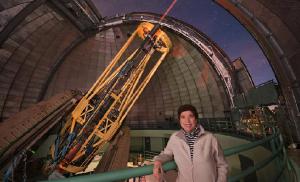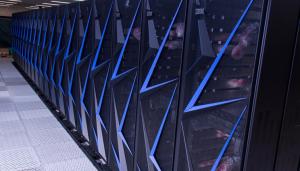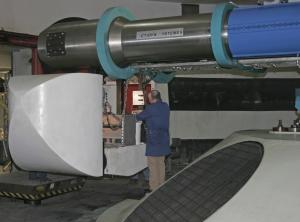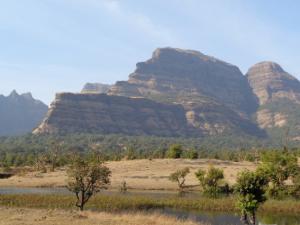LAB REPORT
Science and Technology Making Headlines
Jan. 23, 2015


Claire Max at Lick Observatory, Mount Hamilton. Photo by Laurie Hatch.
Transforming the view of the sky
By firing lasers into the sky, Claire Max has transformed the capabilities of current — and future — telescopes.
Max, a longtime astrophysicist at Lawrence Livermore National Laboratory and a faculty member at UC Santa Cruz, has earned the Joseph Weber Award for Astronomical Instrumentation from the American Astronomical Society for her work in adaptive optics.
She co-invented sodium-laser-guide-star adaptive optics and shepherded adaptive optics, which takes the “twinkle” out of starlight, from its roots in classified space surveillance to its prominence today as an essential technology on large telescopes.
Her work on laser guide stars, which are used with adaptive optics to correct the blurring of telescopic imagery caused by turbulence in the atmosphere, has resulted in an ongoing revolution in ground-based astronomy.

Sierra is the next in a long line of supercomputers at Lawrence Livermore National Laboratory
Heading to the Sierra
The United States may once again be home to the world’s fastest supercomputer. It held the title in 2012, but only kept it for six months — then a computer in China took the top spot. But the U.S. recently put aside more than $400 million to stay in the race.
These kinds of machines are used to do incredibly complex simulations of real-world things, such as analyzing weather patterns over time or predicting new chemical combinations in drugs. Faster computers mean more scientific breakthroughs.
Congress has funded supercomputing with gusto. In November, the Department of Energy pledged $425 million to help build Sierra at Lawrence Livermore National Laboratory and Summit at Oak Ridge.


A technician prepares an experiment in the U.S. Army Corps of Engineers' Engineer Research and Development Center's Centrifuge Research Center.
Dams hold up under shock
There has long been a concern among civil engineers that dams could fail days or weeks after an earthquake, even if no immediate evidence of a problem surfaced.
Their concern has focused on possible cracks at the interface between the concrete section of a dam and the soil embankments at the dam's sides, and on how the soil filters nestled amidst the embankments would fare.
For the first time, under a collaboration between Lawrence Livermore and the U.S. Army Corps of Engineers' Engineer Research and Development Center, researchers have completed a study demonstrating the effectiveness of soil filters at the soil grain scale.
Soil filters consist of coarser grain soils than the soil used in the dam's impervious core, and their purpose in the event of a crack in the soil, is to prevent the finer core soil particles from rapidly eroding and flushing through the filter. This helps reduce the flow of water, preventing the dam's catastrophic failure. Soil filters have been incorporated into dams for more than five decades.


Inside the Omega Laser Facility’s target chamber during a shot. Experiments at this facility have provided insight into magnetic field generation. Photo courtesy of University of Rochester’s Laboratory for Laser Energetics.
Taking a peek into the cosmos
The generation of cosmic magnetic fields has long intrigued astrophysicists. Since it was first described in 1959, a phenomenon of plasma instability present in homogeneous or nearly homogeneous electromagnetic plasmas has generated tremendous theoretical interest from astrophysicists and plasma physicists as a potential mechanism for seed magnetic field generation in the universe.
However, direct observation of this magnetic field remained challenging for decades. But Lawrence Livermore researchers report for the first time well-developed, oriented magnetic filaments generated by the mechanism in counter-streaming, collision-less flows generated by high-power lasers.
“Comparison with 3-D particle-in-cell simulations and a first-principles theoretical treatment proves that the magnetic field generation in such flows is real, and quite efficient,” said lead author Channing Huntington, a physicist at LLNL.


This image was taken during the August 2014 eruption of Tavurvur in Papua New Guinea. Lawrence Livermore researchers identified the climatic signals of some of the larger early 21st-century eruptions.
Volcanoes are hot topic in global cooling
Small volcanic eruptions over the past 20 years have been protecting the Earth from global warming, according to a new study from Lawrence Livermore scientists.
The team confirmed that droplets of sulphur-rich aerosols spewed into the upper atmosphere by volcanoes have been reflecting sunlight away from the Earth. Until recently it was thought that only particularly large eruptions had any noticeable effect on the climate.
However, the new study has confirmed results from the end of last year that showed these small eruptions can have an accumulative impact on global temperature. This could have helped decrease the global temperatures by between 0.05 degrees Celsius to 0.12 degrees Celsius over the past 15 years.





